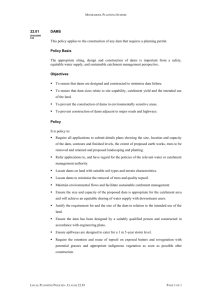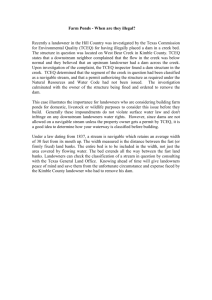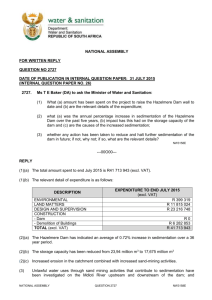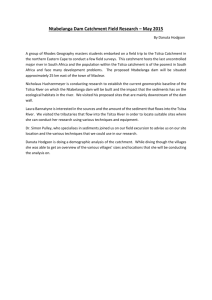Microsoft Word
advertisement
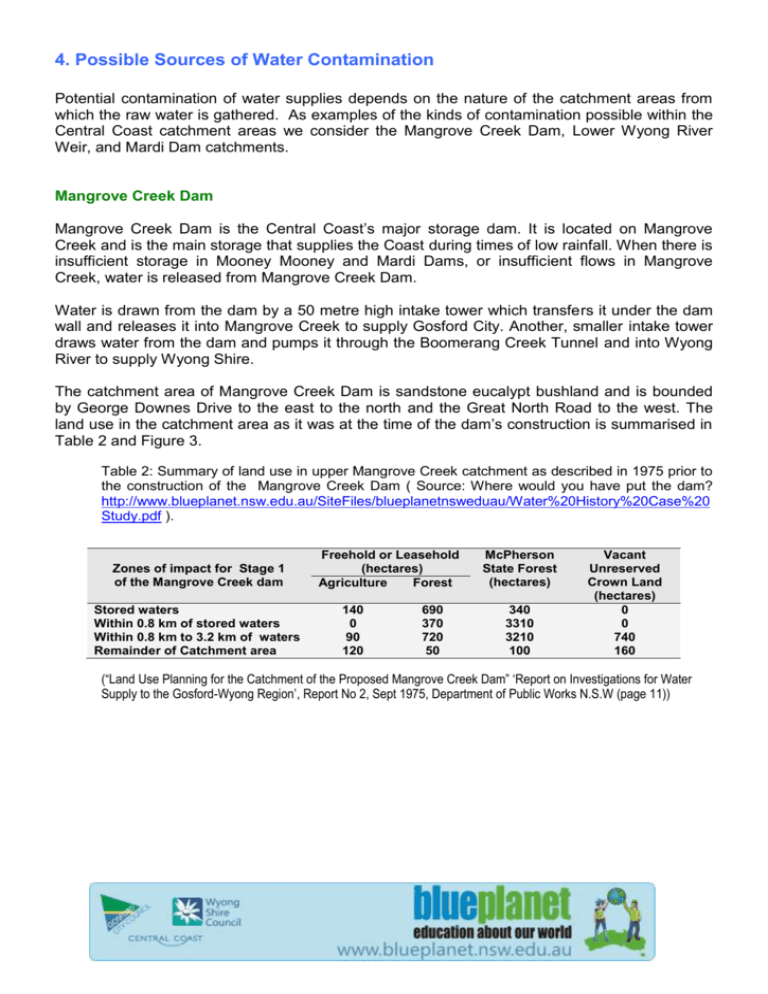
4. Possible Sources of Water Contamination Potential contamination of water supplies depends on the nature of the catchment areas from which the raw water is gathered. As examples of the kinds of contamination possible within the Central Coast catchment areas we consider the Mangrove Creek Dam, Lower Wyong River Weir, and Mardi Dam catchments. Mangrove Creek Dam Mangrove Creek Dam is the Central Coast’s major storage dam. It is located on Mangrove Creek and is the main storage that supplies the Coast during times of low rainfall. When there is insufficient storage in Mooney Mooney and Mardi Dams, or insufficient flows in Mangrove Creek, water is released from Mangrove Creek Dam. Water is drawn from the dam by a 50 metre high intake tower which transfers it under the dam wall and releases it into Mangrove Creek to supply Gosford City. Another, smaller intake tower draws water from the dam and pumps it through the Boomerang Creek Tunnel and into Wyong River to supply Wyong Shire. The catchment area of Mangrove Creek Dam is sandstone eucalypt bushland and is bounded by George Downes Drive to the east to the north and the Great North Road to the west. The land use in the catchment area as it was at the time of the dam’s construction is summarised in Table 2 and Figure 3. Table 2: Summary of land use in upper Mangrove Creek catchment as described in 1975 prior to the construction of the Mangrove Creek Dam ( Source: Where would you have put the dam? http://www.blueplanet.nsw.edu.au/SiteFiles/blueplanetnsweduau/Water%20History%20Case%20 Study.pdf ). Zones of impact for Stage 1 of the Mangrove Creek dam Stored waters Within 0.8 km of stored waters Within 0.8 km to 3.2 km of waters Remainder of Catchment area Freehold or Leasehold (hectares) Agriculture Forest 140 0 90 120 690 370 720 50 McPherson State Forest (hectares) 340 3310 3210 100 Vacant Unreserved Crown Land (hectares) 0 0 740 160 (“Land Use Planning for the Catchment of the Proposed Mangrove Creek Dam” ‘Report on Investigations for Water Supply to the Gosford-Wyong Region’, Report No 2, Sept 1975, Department of Public Works N.S.W (page 11)) Figure 3: Original land use within the Mangrove Creek Dam catchment area. (Source: “Environmental Impact of the Proposed Dam“, Volume 2, “Mangrove Creek Dam – Environmental Impact Statement” 1977, Gosford-Wyong Water Supply, NSW Department of Public Works.) The Mangrove Creek Dam catchment is in excellent condition. The land comprises extensive undeveloped, uninhabited land which helps to maintain a pristine catchment area. The site has a rock foundation. Areas with a sandy base are not suitable for dam construction. The naturally V-shaped valley is the ideal storage with a small surface area compared to volume – which means evaporation at the site is low. The dam site is located relatively close to all other water catchments – which minimises the costs associated with transfer pipelines and pumping stations. One other catchment within the Central Coast supply with similar forested landscape Mangrove Creek Dam is the Mooney Mooney Creek Dam catchment (39 km2). Lower Wyong River Weir Wyong River Weir has a catchment (355 km2) three times the size of that of Mangrove Creek Dam (Figure 4). The weir’s catchment consists of significant areas of agricultural land in contrast to the mainly forest land of the storage dam. Agricultural enterprises include cattle grazing, small scale horticulture and orchard enterprises, and turf production. Other features within the Wyong River catchment include the F3 highway and feeder roads, and the small rural villages of Dooralong, Jilliby and Yarramalong. The business park, airport and new suburbs in the Warnervale area are in the Porters Creek catchment which joins Wyong River below the Weir and so have no influence upon the water supply except during severe drought when water from the Porters Creek wetland has been pumped into the weir. Porters Creek wetland is a natural filter reducing the level of industrial contaminants entering Wyong River below the weir. Land use 25077 % of total area 54.60 11842 25.77 7349 15.99 Orchards 498 1.08 Powerline Easements Water Supply Turf Farms Small Lot Subdivisions Market Gardens Intensive Animal Husbandry Nurseries 449 0.98 202 191 0.44 0.42 82 0.17 69 62 0.15 0.13 46 0.10 Poultry 33 0.07 Villages Community Facilities Roads 27 0.06 9 0.01 Quarries 6 0.01 Hydroponics 5 0.01 State Forest Conservation Bushland Pasture Area (ha) Figure 4: Land use in the Wyong River catchment west of the F3 freeway. Although this data was collected a decade ago land use has not changed significantly since that time. (Source: Wyong Valleys Study Planning Report, Wyong Shire Council, 1998). The catchments for Lower Mangrove Creek Weir (140 km2) and Ourimbah Creek Weir (88 km2) resemble the Lower Wyong River Weir catchment in their mix of minor agricultural pursuits and low density settlement. Mardi Dam Water from Lower Wyong River Weir is pumped to Mardi Dam, then to Mardi Treatment Plant, before being distributed for drinking. In dry times, water can be released from Mangrove Creek Dam through Boomerang Tunnel to the Wyong River and then for drinking water. Mardi Dam itself has a very small catchment of 4 km2 of mainly Eucalypt bushland. Potential Contaminants Potential contaminants of drinking water are of four main types: inorganic nutrients (e.g. ions that contain phosphorus or nitrogen, often arising from agricultural land); organics and biologicals (e.g. manure and algae); potential toxins arising from industry, mining and agriculture (e.g. paints, herbicides and heavy metals like cadmium and lead); pathogenic organisms (e.g. coliform bacteria and Cryptosporidium). Runoff from undisturbed forest will carry twigs, leaves, ash, a small amount of organic topsoil, and very low levels of native animal manure depending on the intensity of the precipitation producing the runoff. These materials will be low in phosphorus and relatively low in nitrogen. By contrast, runoff from agricultural land will have a range of extra components depending on the particular enterprise. From freshly cleared and cultivated farming land, runoff will usually contain soil materials especially after heavy rainfall events; clay and silt particles will be suspended in the runoff leading to high turbidity readings. From established horticultural crop land, runoff may be enriched by nutrients (e.g. phosphorus, nitrogen and potassium) derived from fertilisers and may contain pesticide and herbicide residues. Manure, carcases, and eroded soil materials from livestock country can be additional sources of nutrients and turbidity. Strict environmental controls are placed on dairy, pig and poultry industries to prevent manure reaching waterways. New residential areas, industries, and transport infrastructure (highways and railways) have the potential to produce a lot of eroded soil materials during land clearing and construction. Once established, these areas can be sources of garbage, detergents, oils, greases, heavy metals and faecal coliform bacteria, arising if stormwater and sewage outflows are poorly managed. Table 3 gives some idea of the potential nutrient outflow (N and P) from different land uses in Wyong Shire (but not necessarily located in the drinking water catchment areas). Table 3: Typical nutrient pollution from different land uses in the Shire. (Source: Walkerden G. and Gilmour A. 1996, Tuggerah Lakes and Catchment AEAM Project Final Report, Wyong Shire Council, Wyong.) Land Use Disturbed land Mining Septic residential Intensive agriculture Industry/commerce Turf farms / golf Sewered residential Ash dams Rural residential Extensive agriculture Forestry Bushland Wetlands Phosphorus export rate (kg/Ha/yr) 20.0 10.0 7.0 5.0 3.0 8.0 1.5 1.5 0.6 0.3 0.4 0.1 0.0 Nitrogen export rate (kg/Ha/yr) 60.0 30.0 20.0 10.0 8.0 8.0 7.5 7.5 4.0 3.0 1.5 1.0 0.0

